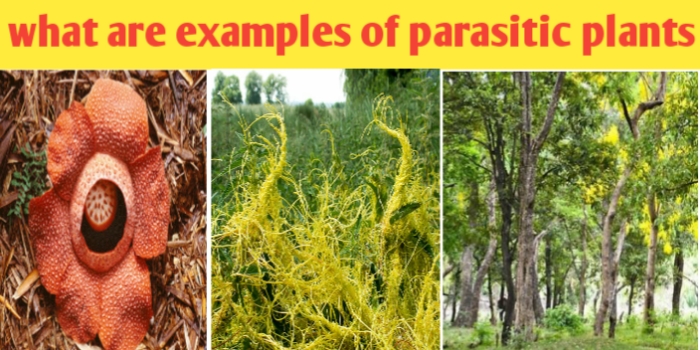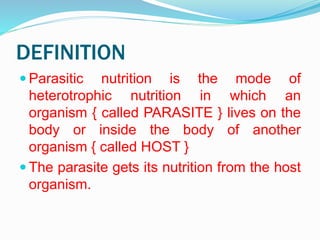Parasitic Nutrition Meaning Example
These plants uses heterotrophic mode of nutrition to derive food for their survival. Modes of Nutrition 1.

Parasitic Nutrition Pptx Oo Pptxom
Saprophytic nutrition is where the organisms feed on dead and decaying matter.

Parasitic nutrition meaning example. The exact meaning of this word is self-nutrition. Click to see full answer. Thus the larger animals are known to be the hosts and the smaller living organisms which acquire nutrition from the hosts are known to be the parasites.
Usually these parasites attack larva or young insects. Parasitic nutrition is a type of nutrition in which the organisms live on or inside the body of their host and derive their food from them. Saprobic or Saprotrophic 4.
This is also known as Liver fluke. When the eggs hatch the parasitic young kill and eat the worm gaining nutrients from it. Parasitic Plants are plants that receive their water and nutrients from other plants.
Cuscuta Amarbel is a yellow tubular plant twisting around the stem and branchesof a tree that does not have. Parasites include single-celled protozoans such as the agents of malaria. Parasitic food chain is a type of food chain that starts from herbivore but the food energy transfers from larger organisms to smaller organisms without killing in case of a predator.
Heterotrophic nutrition can be one of three types holozoic saprophytic or parasitic. Examples include bacteria and fungi. The word parasite comes from the Latin form of the Greek word παράσιτος parasitos meaning one who eats at the table of.
The term autotrophic is formed by the combination of two terms auto meaning self and trophic meaning nutrition. They are- carnivores herbivores and omnivores. Wilson has characterised parasites as predators that eat prey in units of less than one.
Consequently what is difference between Saprophytic and. Mistletoe will attach to their host tree or shrub and then extract water and nutrients. Parasitism is a close relationship between species where one organism the parasite lives on or inside another organism the host causing it some harm and is adapted structurally to this way of life.
Example - fungi etc. Parasitism is a type of symbiotic relationship or long-term relationship between two species where one member the parasite gains benefits that come at the expense of the host member. Mistletoe is not only parasitic.
Parasites are organisms that live in or. Parasitic nutrition - When the organism derives its food from another living organism host without killing it. What does parasitic nutrition mean.
Autotrophic nutrition is a process in which the organism produces its food from simple inorganic materials such as water carbon dioxide and mineral salts in the presence of sunlight. These plants will grow haustoria that attach to the plants. Parasites cause some kind of harm to the body of the host.
The autotrophic organisms contain a green coloured pigment called chlorophyll which helps in trapping energy from the sun. Parasitism Examples-Parasitic Plants. Here are all the possible meanings and translations of the word parasitic nutrition.
Saprophytic Nutrition- This is a kind of heterotrophic nutrition where organisms obtain their food sources from remains of decaying organic substances including dead organisms decomposed leaves and plant remains excreta food articles and moreexamples - Mushroom Mold mycorrhizal fungi etc. Nitrogen fixation bacteria and root nodules of leguminous plants. The organism which obtains the food is called a parasite and the organism from whose body food is obtained is called the host parasite usually harms the host.
The defining structural feature of a parasitic plant is the haustorium a specialized organ that penetrates the host and forms a vascular union between the plants. Saprotrophic nutrition - When the organism obtain its food from decaying organic matter of plants dead animals etc. In layman terms the word can be split into auto self trophic nutrition.
Some parasites like copepods nematodes and leeches attach to the fishs gills and live there. In order to increase the fitness of its own a parasite tries to gain food or. At intervals Cassytha sends out suckers which grows through the stem of the host until it reaches the phloem tissue of the host from which it absorbs manufactured food from the host.
Parasitic plant plant that obtains all or part of its nutrition from another plant the host without contributing to the benefit of the host and in some cases causing extreme damage to the host. Algae and Fungi in a lichen. Parasitic nutrition is where an organism.
Mistletoe This plant you will see high in trees is actually a parasite. It attaches itself onto the liver and makes way to the tissue and bile. In this mode the organisms prepare their food from CO2 and water by utilizing sunlight.
Holozoic nutrition can be seen in most vertebrates and some unicellular organisms like the amoeba. Examples of organisms that exhibits symbiotic feeding are. A parasitic plant is a plant that derives some or all of its nutritional requirement from another living plant.
Saprotrophic nutrition s æ p r ə ˈ t r ɒ f ɪ k-p r oʊ- or lysotrophic nutrition is a process of chemoheterotrophic extracellular digestion involved in the processing of decayed dead or waste organic matterIt occurs in saprotrophs and is most often associated with fungi for example Mucor and soil bacteriaSaprotrophic microscopic fungi are sometimes called saprobes. Mistletoe attaches to a host plant with a special root called a haustorium which it uses to drain the host of water and nutrients. Holozoic or Zoo-Trophic 3.
Examples of symbiotic nutrition. They make up about 1 of angiosperms and are found in almost every biomeAll parasitic plants have modified roots called haustoria which penetrate the host plant connecting them to the conductive system either the xylem the phloem or both. Parasitic modes of nutrition in plants.
The number of parasites exceeds the number of free-living organisms means the parasitic lifestyle has been a successful one over the years. Parasitic plants differ from. Some insects deposit their eggs within the body of another insect species caterpillar.
Mistletoe really wants you to leave it alone. Meaning of parasitic nutrition. Sea anemones and hermit crabs.
The following points highlight the seven modes of nutrition in protists. Wikipedia 300 2 votes Rate this definition. The literal meaning of this term is self-nutrition.
TYPES OF PARASITIC PLANTS. Following are the examples of parasitic symbiosis. Santalales is a festive holiday plant that has some unpleasant feeding habits.
The relationship between two species where one organism which is called the parasite lives on or within the body of the other organism which is called the host this relationship is known as parasitism. CASSYTHA FILIFORMIS DODDER Cassytha is a thin thread-like stem which normally coils around the stem of anther plant. There are certain plants in nature which do not have chlorophyll and hence cannot produce their own food.

What Are Parasitic Plants Explain With An Example Biologysir

In Which Of The Following Groups Of Organisms Food Material Is Mcq

Parasitic Nutrition Pptx Oo Pptxom

Heterotrophic Nutrition Definition Types Examples

Describe Parasitic Nutrition No Spam Brainly In

Difference Between Parasitic Nutrition And Saprophytic Nutrition Youtube

Heterotrophic Nutrition Definition Types Examples Class 10 Cbse Class Notes Online Classnotes123

Nutrition And Respiration Ppt Video Online Download

What Is Parasitic Nutrition What Does Parasitic Nutrition Mean Parasitic Nutrition Meaning Youtube
Post a Comment for "Parasitic Nutrition Meaning Example"